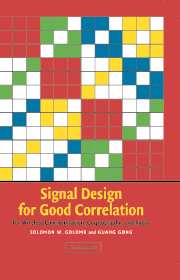Book contents
- Frontmatter
- Contents
- Preface
- Acknowledgments
- Historical Introduction
- 1 General Properties of Correlation
- 2 Applications of Correlation to the Communication of Information
- 3 Finite Fields
- 4 Feedback Shift Register Sequences
- 5 Randomness Measurements and m-Sequences
- 6 Transforms of Sequences and Functions
- 7 Cyclic Difference Sets and Binary Sequences with Two-Level Autocorrelation
- 8 Cyclic Hadamard Sequences, Part 1
- 9 Cyclic Hadamard Sequences, Part 2
- 10 Signal Sets with Low Crosscorrelation
- 11 Correlation of Boolean Functions
- 12 Applications to Radar, Sonar, Synchronization, and CDMA
- Bibliography
- Index
10 - Signal Sets with Low Crosscorrelation
Published online by Cambridge University Press: 15 August 2009
- Frontmatter
- Contents
- Preface
- Acknowledgments
- Historical Introduction
- 1 General Properties of Correlation
- 2 Applications of Correlation to the Communication of Information
- 3 Finite Fields
- 4 Feedback Shift Register Sequences
- 5 Randomness Measurements and m-Sequences
- 6 Transforms of Sequences and Functions
- 7 Cyclic Difference Sets and Binary Sequences with Two-Level Autocorrelation
- 8 Cyclic Hadamard Sequences, Part 1
- 9 Cyclic Hadamard Sequences, Part 2
- 10 Signal Sets with Low Crosscorrelation
- 11 Correlation of Boolean Functions
- 12 Applications to Radar, Sonar, Synchronization, and CDMA
- Bibliography
- Index
Summary
In this chapter, we introduce constructions for signal sets with low crosscorrelation. These sequences have important applications in wireless CDMA communications. There are three classic constructions for signal sets with low correlation, namely, the Gold-pair construction, the Kasami (small) set construction, and the bent function signal set construction. In Section 10.1, we introduce some basic concepts and properties for crosscorrelation of sequences or functions, signal sets, and one-to-one correspondences among sequences, polynomial functions, and boolean functions. After that, three classic constructions will be presented in Sections 9.2, 9.3, and 9.4 respectively. With the development of new technologies, the demand for constraints on other parameters, such as linear spans of sequences, and the sizes of the signal sets has increased. Here, we will provide two examples of constructions that sacrifice ideal correlation in order to improve other properties, in Sections 9.5 and 9.6, respectively. One example is the interleaved construction for large linear spans, and the other is ℤ4 sequences to obtain large sizes of signal sets.
Crosscorrelation, signal sets, and boolean functions
In this section, we discuss some basic properties of crosscorrelation of sequences (some of them have been discussed in Chapter 1), refine the concept of signal sets, and develop the one-to-one correspondence between sequences and boolean functions. (Note that the one-to-one correspondence between sequences and functions is discussed in Chapter 6.)
We will keep the following notation in this section.
- Type
- Chapter
- Information
- Signal Design for Good CorrelationFor Wireless Communication, Cryptography, and Radar, pp. 323 - 382Publisher: Cambridge University PressPrint publication year: 2005



